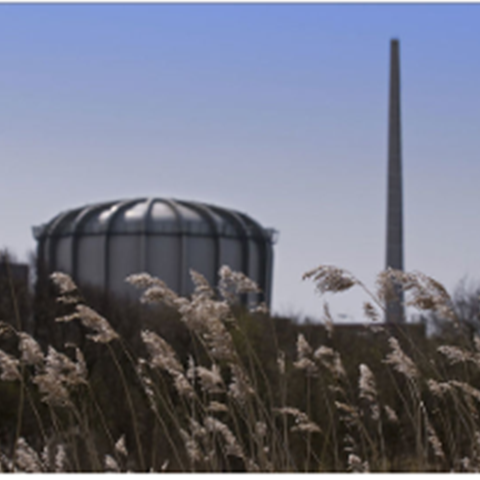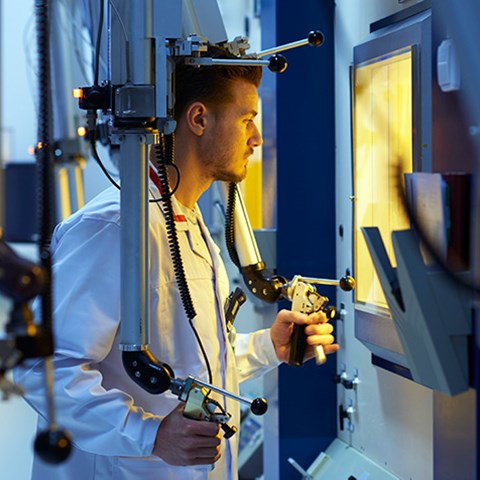Nuclear Infrastructure
The reactor and our facilities
The Energy & Health Campus in Petten is home to a unique combination of nuclear installations. Over the past 60 years, the site has expanded and acquired international allure. With the knowledge developed in these facilities and the continuous production of medical isotopes, our services and products are literally lifesaving.
Numerous preparations are also being made for the future and a new research laboratory is being built called FIELD-LAB, where new nuclear medicines will be developed. The production of medical isotopes is being expanded and planning permission has been requested for the construction of the Nuclear Health Center by the Foundation Preparation Pallas-reactor. This foundation is also applying for planning permission for the PALLAS reactor, the successor of the HFR. We are building for the future.
More

The High Flux Reactor
The HFR is one of the few reactors in the world which can make nuclear medicines (medical isotopes). Every day, substances for nuclear medicines are produced for 30,000 patients. These patients are suffering from cancer or some other life-threatening disease. The reactor is also frequently used for research into safe and new nuclear energy, such as research into Thorium reactors. The HFR has been in operation since 1961. In the mid-2020s, the HFR will be replaced by the new PALLAS reactor, for which construction plans are currently being prepared.
Reactor
Of 30 days, this gives the reactor its high availability.
The High Flux Reactor is a 45 Megawatt-material test reactor.
Due to the High Flux, it is possible to look ahead in time, 10 times faster.
Patients are helped every day with medical isotopes from the reactor.
Hot Cell Laboratories
The HFR is one of the few reactors in the world which can make nuclear medicines (medical isotopes). Every day, substances for nuclear medicines are produced for 30,000 patients. These patients are suffering from cancer or some other life-threatening disease. The reactor is also frequently used for research into safe and new nuclear energy, such as research into Thorium reactors. The HFR has been in operation since 1961. In the mid-2020s, the HFR will be replaced by the new PALLAS reactor, for which construction plans are currently being prepared.

NRG is a global leader in the production of medical isotopes
Molybdenum Production Facility
In the Molybdenum Production Facility (MPF), molybdenum-99 is extracted from irradiated targets. The molybdenum-99 is held in a special container (a 'generator') that is used in hospitals to 'draw off' technetium-99m. The molybdenum-99 decays with a half-life of around 60 hours into technetium-99m, which is then used to make scans (SPECT, Single Photon Emission Computed Tomography) of patients.
The medical isotopes which are irradiated in the reactor undergo further processing in the Molybdenum Production Facility. Curium makes nuclear medicine suitable for doctors, enabling 30,000 patients to be treated every day.

Jaap Goedkoop Laboratory
In the Jaap Goedkoop Laboratory (JGL), our staff studies the development of new nuclear medicines to treat patients. Solutions for radioactive waste are also sought in this laboratory. By carrying out extra irradiations of radioactive waste, we reduce the amount of waste in the long term. The life span of radioactive waste can be significantly shortened. The laboratory uses advanced instruments which can detect the changes in the properties of materials used for nuclear reactors, in order to assess the effects of ageing.
The JGL is named after Prof. Dr. J.A. Goedkoop, former scientific director of the Dutch Reactor Centre, and founder of the nuclear infrastructure in Petten, and in the Netherlands.
Decontamination & Waste Treatment
Our Decontamination & Waste Treatment (DWT) is used for cleaning of radioactively contaminated materials. Often these are installation parts from the nuclear infrastructure in Petten, or from offshore oil and gas extraction. In these offshore installations, natural radioactivity accumulates which has come up from deep under the ground. We clean the contaminated materials. The radioactive waste is separated, collected, packed and transported to COVRA (Central Organisation for Radioactive Waste) in Borsele.
Waste Storage Facility
The HFR is one of the few reactors in the world which can make nuclear medicines (medical isotopes). Every day, substances for nuclear medicines are produced for 30,000 patients. These patients are suffering from cancer or some other life-threatening disease. The reactor is also frequently used for research into safe and new nuclear energy, such as research into Thorium reactors. The HFR has been in operation since 1961. In the mid-2020s, the HFR will be replaced by the new PALLAS reactor, for which construction plans are currently being prepared.

